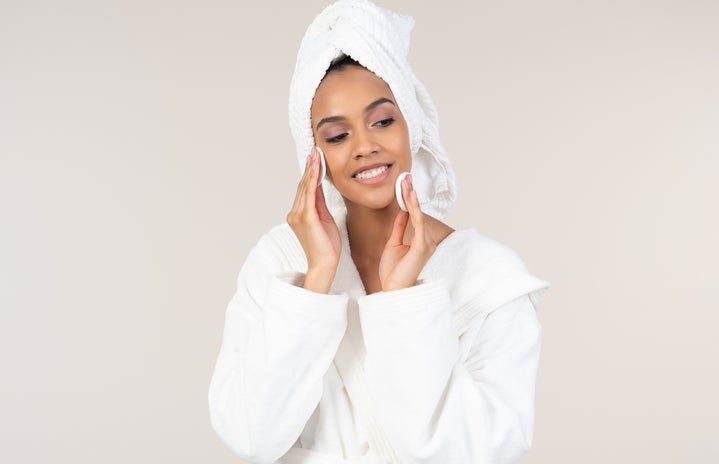Honestly, Cetaphil should just sponsor me at this point.
As someone who has struggled with acne their entire life and has been on Accutane, I am very disciplined when it comes to keeping up with my skincare routine. I’ve locked down a routine that works for me and my skin, and I feel really good about it. It took a lot of trial and error though. After many years (and many products!), my family doctor agreed to refer me to a dermatologist, who wrote me an Accutane prescription. Almost immediately, there was a huge improvement in the general feel and look of my skin.
Since my Accutane journey has ended, I’ve made it a point to take extra good care of my skin, not only to maintain the Accutane’s results, but make my skin feel as good as possible. I’ve done tons of research on the best products and ingredients for my skin (ceramides: excuse me, um, I love you) and the importance of exfoliating. So, without further ado, here are my best and most practical tips for an effective skincare routine that will make you shine from the inside out.
1. Listen to your skin.
I cannot stress this enough. I’ll be honest, it’s so tempting to break the bank on skincare products that claim to have astounding results (guilty as charged!). Still, dermatologists advise against combining too many different ingredients and products at once. Instead, introduce new products gradually and see how your skin reacts. Generally, it’s normal to see breakouts within the first six weeks; this is just your skin getting used to the new products, in a process known as skin purging. However, if breakouts persist for longer than that, talk to your dermatologist ASAP about finding products that would be better for you.
Also, pay extra attention to how your skin feels in extreme temperatures, like in the middle of winter and in the middle of summer. Skin tends to dry out way more than usual as the weather gets colder, and produces more sweat and oil in the warmer months, which can lead to breakouts. You may have to make some adjustments to your skincare routine during these times to make sure you’re giving it adequate TLC. Hydration is the most important, so make sure you’re using hyaluronic acid (I’m obsessed with the Optimal Hydration Serum and Daily Glow Cream from Cetaphil) and a moisturizer suited to your skin type daily.
2. Choose your skincare products wisely.
Finding products that work for you also means choosing skincare products that are meant for your specific skin type, whether it be dry, oily, or combination skin. If you’re not sure what your skin type is, I recommend talking to your dermatologist, as they can probably give you the most accurate information and product recommendations. You can also take diagnostic tests for free online (for example, this one on the Paula’s Choice website) that can help determine your skin type and recommend a routine and products for to your needs. Even if you’re not down to try their specific recommendations, tests like these are still useful to get a sense of which ingredients and formulas best suit your skin.
3. Hailey Bieber said it first: double-cleansing is a game-changer.
Double cleansing involves using an oil-based cleanser first, followed by a water-based cleanser to wash your face before bed. It’s a great way to make sure you’re washing your face thoroughly. This has become even more important since we’ve started wearing masks, which can trap sweat, oil, and dirt.
As someone who has super oily skin, I was skeptical about this process at first, like: what’s the point of putting more oil onto my skin if that’s what I’m trying to control? The product that’s worked for me is the CeraVe Hydrating Micellar Water, which effectively removes makeup and dirt while also hydrating the skin and maintaining its moisture barrier. I use this product with a cotton pad on my face once a day (some people do it twice a day, but I find that it strips my skin too much) and follow it up with the Cetaphil Oil Control Foaming Cleanser. Again, make sure you’re listening to your skin; swap out as needed with products that suit your skin type, and don’t overuse any product to the point that it strips your skin.
4. Read the ingredients in your skincare products.
The ingredients in your products are just as important as the products themselves and are key to acheiveing good results. You want to read the ingredients for two reasons: 1) so you don’t accidentally mix ingredients that are not compatible, like retinol and vitamin C, and 2) to make sure the ingredients are safe for your skin type. In general, alpha-hydroxy acids in toners and exfoliators work best for super dry skin types, while beta hydroxy acids (like salicylic acid) work best for oily, acne-prone skin types.
To learn more, you can take a look at this fantastic article that goes into a deep dive on which ingredients are good to mix and which are not.
5. Make sure you’re applying your skincare in the correct order
Make sure you’re allowing your products to absorb properly into your skin, especially when layering your skincare. Start with a clean face before applying your fancy serums and face oils, and apply them in order from lightest to thickest. For example, start with your cleanser and then apply your toner, serums, and spot treatments. Moisturizer should be the last product you apply. Here’s a great visual that breaks down the exact steps for your morning and night skincare in the exact order of application (bonus: it also recommends products that go well together!). Wait for about 15-60 seconds between skincare products to make sure everything absorbs into your skin thoroughly and adequately.
I can honestly say that layering my skincare has made a world of difference in how my skin looks on the outside and how it feels. There’s no better feeling than going to bed with my skin feeling refreshed, silky smooth, and hydrated.
6. SPF over 50 is key.
If there’s one thing to remember from this article, please let it be this one. There are so many scientifically proven benefits to using SPF daily, from preventing sunburn and skin cancer to keeping your skin looking youthful and healthy.
If you’re looking to get started with SPF, here are two tips to get you started: Make sure you’re using SPF 50, as it offers more protection against the harmful effects of the sun. Consider using a standalone SPF product rather than an SPF-moisturizer combo. Personally, I prefer using a moisturizer/sunscreen in the winter and separate products in the summer, since I apply it more often in the hotter months.
Winter is already here! Follow these tips to make sure you’re giving your skin the protection it deserves in the cold months ahead.


